
A walk along the Jirón Sáenz Peña in Lima, Peru
Last week I found a marvellous program on the internet, called "Heygo". You can join guided tours from all over the world, live and for free. Live means "in real time" with a chat to ask questions to the guide. Free means that you may participate for free, but you should leave a tip, in order to keep the program (and the guides of course) going. Mostly English is spoken, but there are a few in other languages, if you can wait some days.
The tour I joined today was guided by Vanessa Vazquez and titled: "Neighbourhoods of Lima: Barranco and all the XX century styles of Lima". Vanessa is, by the way, amazing with all her knowledge and the way she forwards it.
|
The "styles" relate to architecture, and there is a lot of other information, that you can get out of a lecture.
All right, let's go. Barranca is one of the oldest districts of the city, about eight kilometres from the center and is considered a wealthy area. We start at the Jirón Sáenz Peña and follow the avenue down to the sea. Lima is the only city in Peru, which lies directly at the sea. There are very few houses, that are built in only one distinct style, most of them are a combination of more influences. The first house we look at is built in Art Deco. Vanessa points out the straight lines and the stylised decoration above the windows. She tells us, that Art Deco often is seen as a masculine style, whereas the Art Nouveau, from which Art Deco developed is more feminine in its forms.
|
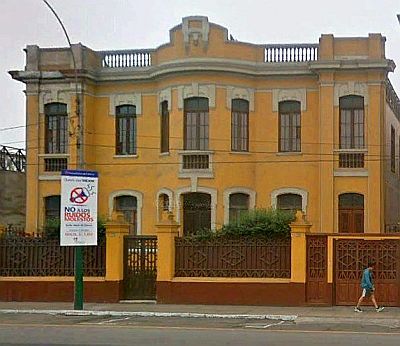 |
On the neighbouring house there are more typical forms for the Art Nouveau, for instance the flowerly frieze beneath the roof and the style not as strict as in Art Deco. Flowers as elements in the architecture are important, in Italy it is even called "Stile Floreale". The origins of Art Nouveau are found in Austria, Belgium and Catalunya, in what is called Jugendstil (Youth style), or in Spain "Modernisme", because it was a protest against historism and norms.
Participating in such a tour has more advantages. When a guide turns around, you get an impression of general city life as well.
|
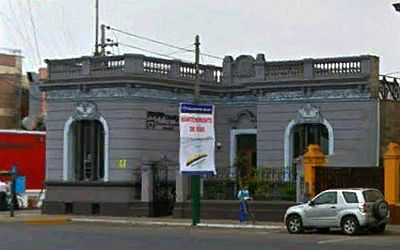 |
|
That way we can have a look at the Jirón Sáenz Peña, which we are going to follow towards the sea. But who was that Sáenz Peña? There were actually two of them, father and son. Both were lawyers and politicians. Both were Argentinians and both became President of that country. The son, Roque Sáenz Peña is seen as the father of democracy in Argentina. In 1912 he implemented the general suffrage, which is known as the "Law Sáenz Peña". Well, but if he was from Argentina, why is a street named after him in Peru? Because he participated on the peruvian side in the "Guerra del Pacífico".
|
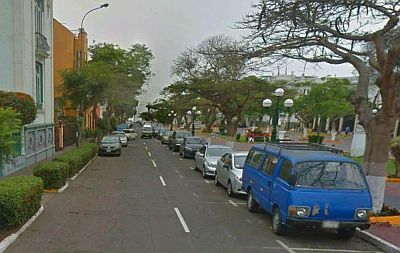 |
That war happened between 1879 and 1884, when Chile attacked Peru and Bolivia. Most of today's buildings are from the twentieth century, as most of the older ones had been destroyed in the war.
One of our participants asked what kind of tree that was, which we were standing under. Our guide gave probably a local name, which I didn't understand, but a little browsing online showed, that it must be a Carob tree. In English (and German) it is also called "St. John's bread". Those oblong black pods are quite revealing. They, as well as the seeds inside, can be used as sweetener, but also as medical treatment.
|
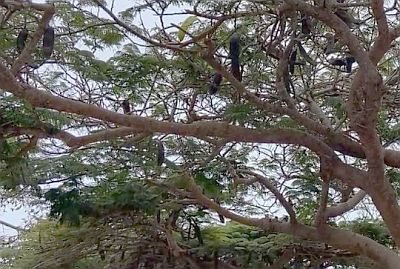 |
The next stop we made at a house that is part of a university. We were told, that this is a private university, which sounds strange to me. If it is private, there are probably more than one. But if there are, it must be difficult to keep the quality of teaching on the same level? On the other hand: this is why it is so exiting to get to know different ways of managing life. Other countries, other customs, is a saying.
But we talked also about the architectural style. This one is called "Brutalism", but it has nothing to do with violence. The word derives from French "béton brut", which - freely translated - means "crude cement".
|
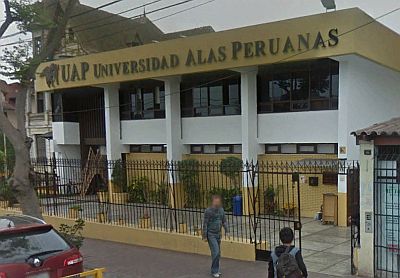 |
And yes, it often is the naked cement you can see on the buildings, with straight, edgy forms. In many countries there is a problem with the erosion of this material. But as it almost never rains in Lima, the cement isn't affected at all.
Right next to the university we found another house, but with a very different style. We, the participants got a chance to look at it a while, to decide, which architectural style we were dealing with here. I looked at the woodwork on the upper part of the tower and under the roof in front. That reminds me very much of what is called woodwork-houses (Fachwerkhäuser) in Europe, mainly in Germany and Denmark. Here they are called Tudor style. The pillars in front are another indication, even if they are not very ornamented. And finally, the very steep roofs, which are absolutely not necessary here in Lima, without any precipitation. Whereas in England there is a lot of rain and even snow in winter.
|
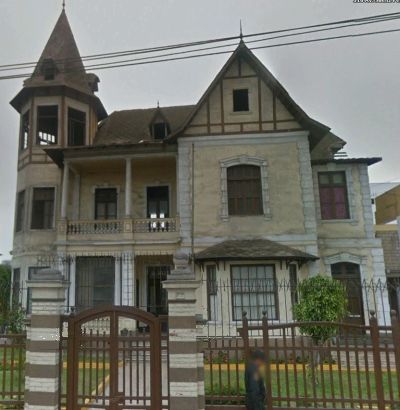 |
Therefore it is very important that it must not stay on the roof, as not to damage it. So my answer was definitely "Tudor style", which was correct.
Next we came to the García Calderón-house. Francisco García Calderón was a remarkable man. He was teaching at the university, Philosophy and Mathematics. He became also a lawyer and even a politian, active in rather high positions.
Our guide told us, that the house was built in eclectic style. That means that different parts were built in different styles.
|
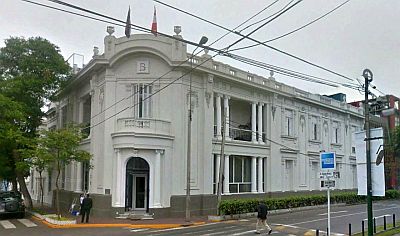 |
Its elements are inspired by a mixture of historical styles, in order to produce something new. And - in my opinion - this fits well together in this case.
On the other side of the street we saw a house, which absolutely was built in the brutalist style. And here the word has a double meaning, as the residents are the "Asociacion Mutualista de Tecnicos y Suboficiales de la Fuerza Aerea del Peru." That means that the house belongs to the military, or, to be more exact, to the Peruvian Air Force.
|
Personally I am not very fond of neither the style, nor the military. I dislike brutality in every form.
Now we had almost reached the sea and thus the end of the street. But there was one last building, that we should have a look at. Also this was a mixture of styles, and here it was even more obvious.
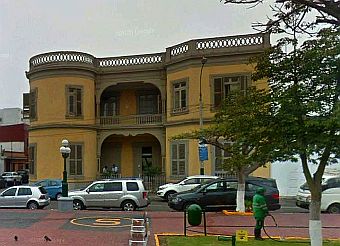
|
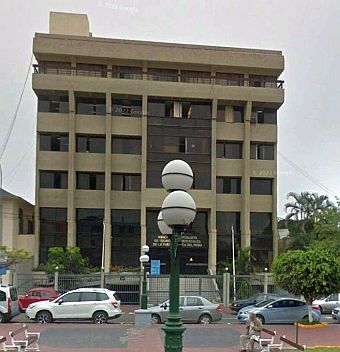 |
|
I feel very happy, having had the possibility to get a glimpse of Lima and to experience new impressions, from places, which I might not be able to see on the spot.
Thank you Vanessa, for a very nice walk together, with a lot of explanations. It is always good to learn new things. And thank you Heygo, that you make this kind of lectures or guiding tours possible.
|
Copyright Bernhard Kauntz, Västerås 2022
Back to  or to the or to the  of of 
last update: 4.7.2022 by webmaster@werbeka.com
|

